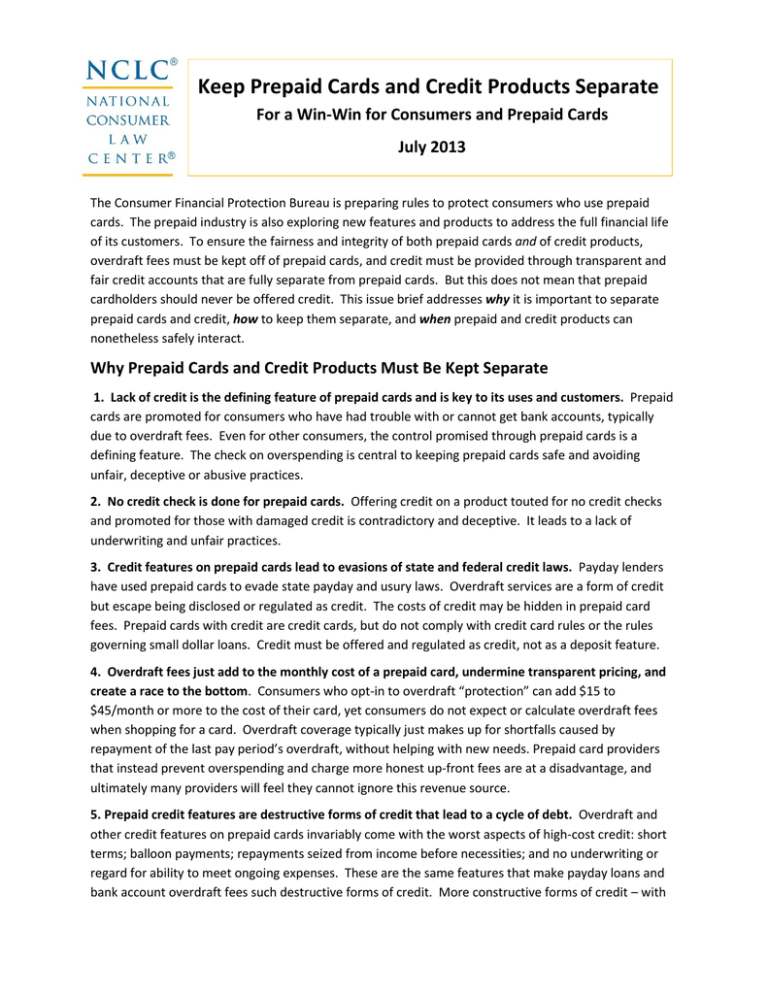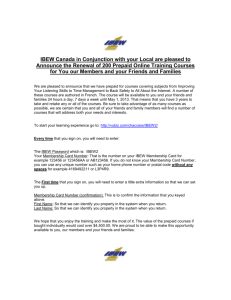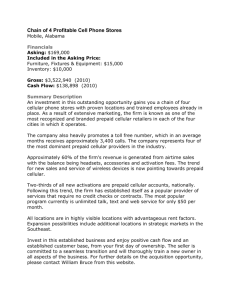Keep Prepaid Cards and Credit Products Separate
advertisement

Keep Prepaid Cards and Credit Products Separate For a Win-Win for Consumers and Prepaid Cards July 2013 The Consumer Financial Protection Bureau is preparing rules to protect consumers who use prepaid cards. The prepaid industry is also exploring new features and products to address the full financial life of its customers. To ensure the fairness and integrity of both prepaid cards and of credit products, overdraft fees must be kept off of prepaid cards, and credit must be provided through transparent and fair credit accounts that are fully separate from prepaid cards. But this does not mean that prepaid cardholders should never be offered credit. This issue brief addresses why it is important to separate prepaid cards and credit, how to keep them separate, and when prepaid and credit products can nonetheless safely interact. Why Prepaid Cards and Credit Products Must Be Kept Separate 1. Lack of credit is the defining feature of prepaid cards and is key to its uses and customers. Prepaid cards are promoted for consumers who have had trouble with or cannot get bank accounts, typically due to overdraft fees. Even for other consumers, the control promised through prepaid cards is a defining feature. The check on overspending is central to keeping prepaid cards safe and avoiding unfair, deceptive or abusive practices. 2. No credit check is done for prepaid cards. Offering credit on a product touted for no credit checks and promoted for those with damaged credit is contradictory and deceptive. It leads to a lack of underwriting and unfair practices. 3. Credit features on prepaid cards lead to evasions of state and federal credit laws. Payday lenders have used prepaid cards to evade state payday and usury laws. Overdraft services are a form of credit but escape being disclosed or regulated as credit. The costs of credit may be hidden in prepaid card fees. Prepaid cards with credit are credit cards, but do not comply with credit card rules or the rules governing small dollar loans. Credit must be offered and regulated as credit, not as a deposit feature. 4. Overdraft fees just add to the monthly cost of a prepaid card, undermine transparent pricing, and create a race to the bottom. Consumers who opt-in to overdraft “protection” can add $15 to $45/month or more to the cost of their card, yet consumers do not expect or calculate overdraft fees when shopping for a card. Overdraft coverage typically just makes up for shortfalls caused by repayment of the last pay period’s overdraft, without helping with new needs. Prepaid card providers that instead prevent overspending and charge more honest up-front fees are at a disadvantage, and ultimately many providers will feel they cannot ignore this revenue source. 5. Prepaid credit features are destructive forms of credit that lead to a cycle of debt. Overdraft and other credit features on prepaid cards invariably come with the worst aspects of high-cost credit: short terms; balloon payments; repayments seized from income before necessities; and no underwriting or regard for ability to meet ongoing expenses. These are the same features that make payday loans and bank account overdraft fees such destructive forms of credit. More constructive forms of credit – with longer terms, affordable installment payments, and concern for the consumer’s ability to pay – can be offered as separate accounts and do not need to be offered as a prepaid card feature. 6. Overdraft credit is unnecessary for prepaid cards and is a crude, unfair form of credit. “Overdraft protection” on accounts that lack checks is nothing more than a poorly designed form of high-cost credit. All transactions are covered, even ones the consumer would choose to forgo; credit is often triggered inadvertently; fees are huge and usually unrelated to the amount of credit; overdraft “protection” is implied but not promised; the consumer is not told how much credit she is given; and the tiny amount of credit given is unlikely to help with unexpected expenses. Permitting overdraft fees on prepaid cards will lead to unfair, deceptive and abusive practices. 7. Prepaid credit features undermine protections for income needed for necessities. State and federal laws protect public benefits, pensions and wages that are needed for necessities by the most vulnerable in our society – elders, individuals with disabilities, and unemployed or low-wage workers. Protections against garnishment are evaded when a creditor can seize the income through offset or mandatory electronic payments from a prepaid card. How to Keep Prepaid Cards and Credit Products Separate Credit has no place on prepaid cards. But that does not mean that prepaid cardholders should never be offered credit. Some consumers have no capacity to repay credit, but some do. The following rules will protect the integrity and fairness of both prepaid cards and credit products. 1. Credit should be offered as a fully separate account. Credit should be offered directly as a separate credit account, based on ability to repay, in full compliance with state and federal laws governing credit. Credit should not be offered indirectly as overdrafts on prepaid cards or as a feature accessible only through the card. 2. Any fees or charges associated with credit should be charged to the credit account. The costs of credit should not be obscured in fees charged to the prepaid card, such as “load,” “transfer,” “negative balance,” “overdraft,” or other fees associated with accessing credit. Keeping all credit-related costs within the credit account will also avoid evasions of payday loan laws, state interest rate caps, and protections for loans to the military. 3. A prepaid card should never directly access a credit feature or account. If a prepaid card has insufficient funds, the transaction should be declined, and no fee should be charged. The consumer can then make the conscious choice whether to use a credit account directly or to transfer funds from a separate credit account to the prepaid card (subject to the other rules described here). Modern technology offers many options for the consumer to learn when the prepaid card balance is low or a transaction has been declined and to make other arrangements to cover the payment. 4. Consumers should not be required to pledge access to their prepaid card accounts as a condition of credit. Prepaid cards are often the last refuge for those who have had trouble with credit or bank accounts, or just want a safe place to manage their funds. A Treasury rule prohibits direct deposit of federal payments to prepaid cards that have overdraft or other credit features, keeping federal payments safe and ensuring that credit is extended based on ability to pay, not ability to collect. But the 2 rule does not apply to every card. There are also gaps in other federal laws that protect deposit accounts from creditors. Banks cannot take offsets against deposit accounts to collect credit card debt, and creditors cannot require consumers to authorize recurring electronic payments as a condition of a loan. But these rules do not apply to every form of credit, especially high-cost, short-term, balloonpayment loans. Prepaid cards need particularly strong protection against creditors who seize deposits before the consumer pays for necessities, including food and rent. 5. Consumers should never be required to use a specific prepaid card to receive the proceeds of credit. Consumers may choose to have the proceeds of loans deposited onto a prepaid card, or to transfer funds from a credit account to a prepaid card. But that should be a choice, not a condition of credit or a choice made under coercion. Credit products that are tied to specific prepaid cards can induce consumers into incurring fees on a prepaid card they would not otherwise choose. Or, the consumer could be induced to give up a bank account and redirect a direct deposit to a more limited or expensive prepaid card. Keeping the credit account and a deposit account separate will ensure freedom of choice and competition among different prepaid cards and bank accounts. Ways in which Prepaid Cards and Credit Products May Effectively Interact Keeping prepaid cards and credit products separate does not mean that prepaid cardholders cannot be offered credit, that the same company cannot offer both a prepaid and a credit account, or that the two accounts may not have some interactions. The five rules previously described are designed to ensure the integrity of the costs and protections for both prepaid cards and credit accounts. If those rules are followed, consumers may find it convenient to have both a prepaid card and credit account with the same provider and to manage those accounts together. Here are some examples: Credit card. A company could offer both a prepaid card and a credit card, and the consumer could transfer cash advances to the prepaid card. However, the consumer must be able to access the cash advance without using the prepaid card, and any fees must be charged to the credit card, not the prepaid card. Mobile wallet. A company could offer a mobile wallet with both a credit card and a prepaid card, and transfers could be made from the credit account to the prepaid card, as with the credit card above. Small dollar loan. A company could offer to deposit the proceeds of a loan to a prepaid card. But the consumer must be offered the free and easy option of receiving the loan another way, such as direct deposit to another account, a check or cash. The company could not require electronic repayment from the prepaid card but could offer a modest discount for electronic payment, consistent with the existing rules for installment loans. This document builds on the body of work on prepaid debit cards by the National Consumer Law Center; visit www.nclc.org/issues/prepaid-debit-cards.html. For more information, contact Lauren Saunders, managing attorney, National Consumer Law Center, (202) 595-7845 or lsaunders@nclc.org. 3






